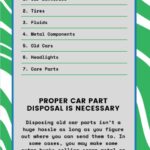Revitalizing your car’s appearance doesn’t always require expensive professional services. Often, a fresh coat of paint on faded or worn plastic car parts can make a significant difference. From mirror caps to bumper trims, spray painting plastic components is a cost-effective way to customize your vehicle and restore its showroom shine. This guide provides all the essential information you need to expertly spray paint plastic car parts at home, achieving a professional-looking finish.
Identifying Plastic Car Parts Suitable for Painting
Before you begin, it’s important to know which plastic parts on your car can be safely and effectively painted. While most exterior plastic trims are paintable, variations exist across different car makes and models. Always check your vehicle’s specifications if you are unsure.
Here are common plastic car parts that are typically suitable for spray painting:
- Trim pieces (window, door, body side moldings)
- Door handles
- Side mirrors and mirror caps
- Bumpers and bumper covers
- Wheel covers and hubcaps
- Spoilers and body kits
- Mudguards and splash shields
Essential Tools and Materials for Painting Plastic Car Parts
To achieve a professional spray paint finish on plastic car parts, you’ll need to gather the right tools and materials. Here’s a comprehensive list:
- Sandpaper of varying grits: Start with coarser grits (e.g., 220-grit) for initial sanding and progressively move to finer grits (e.g., 400-grit, 600-grit, and even wet sanding with 800-grit for an ultra-smooth finish) to prepare the plastic surface.
- Automotive Spray Paint for Plastic: Specifically formulated paints designed for plastic surfaces are crucial. These paints offer better adhesion and flexibility, reducing the risk of cracking or peeling. Choose your desired color and finish (matte, gloss, satin).
- Respirator Mask: Safety is paramount. Always wear a respirator mask when working with spray paints and primers to avoid inhaling harmful fumes.
- Plastic Primer: A specialized primer for plastic is essential. It creates a bonding layer that allows the paint to adhere properly to the plastic surface, ensuring a durable and long-lasting finish.
- Masking Tape: High-quality masking tape, such as Perforated Trim Masking Tape for curves or Flat Orange Precision Masking Tape for straight edges, is necessary to protect surrounding areas from overspray and achieve clean paint lines.
- Clear Lacquer (Clear Coat): A clear lacquer or top coat adds a protective layer over the color paint, enhancing its shine and durability. It also provides UV protection and resistance to scratches and weather elements.
- Microfiber Cloths: Essential for cleaning surfaces, wiping away dust, and polishing the final finish.
- Degreaser or Plastic Cleaner: To thoroughly clean the plastic parts and remove grease, wax, or contaminants before sanding and painting.
- Tack Cloth: To remove any remaining dust particles just before applying primer and paint, ensuring a flawless finish.
- Optional: Plastic Adhesion Promoter: For certain types of plastic that are notoriously difficult to paint, an adhesion promoter can further enhance paint adherence.
Step-by-Step Guide: Preparing Plastic Car Parts for Painting
Proper preparation is the most critical step in achieving a professional spray paint finish on plastic car parts. Rushing this stage can lead to paint failure, peeling, or an uneven appearance.
1. Removal or Masking:
Begin by deciding whether to remove the plastic part from the car or mask around it.
- Removal: Removing the part is generally recommended as it allows for easier access and more thorough painting. For parts like trim pieces, carefully use a plastic trim removal tool or a thin, flat tool to gently pry them away from the car body. Exercise caution to avoid damaging the surrounding paintwork or breaking the plastic clips holding the trim in place.
- Masking: If removal is not feasible or practical, meticulously mask off the surrounding car body panels using masking tape and paper or plastic sheeting. For curved areas, perforated masking tape is ideal for creating smooth, clean lines. Ensure complete coverage to prevent any overspray. Double-check for gaps where paint could seep through and press the tape firmly to secure it.
2. Cleaning the Plastic Surface:
Thoroughly clean the plastic part to remove dirt, grime, grease, wax, or any contaminants. Use a degreaser or plastic-specific cleaner and a microfiber cloth. If there is any wax or silicone residue, use a wax and grease remover. Ensure the surface is completely clean and dry before proceeding.
3. Sanding for Adhesion:
Sanding is crucial to create a surface that primer and paint can properly adhere to. Plastic surfaces are typically smooth and glossy, which hinders paint adhesion. Sanding creates microscopic scratches, providing “tooth” for the paint to grip.
- Start with Coarse Grit: Begin sanding with 220-grit sandpaper to lightly roughen the surface and remove the glossy finish.
- Progress to Finer Grits: Gradually move to finer grits like 400-grit and then 600-grit to smooth out the sanding marks and create a progressively smoother surface. For an even finer finish, wet sand with 800-grit sandpaper. Keep the sandpaper lubricated with water during wet sanding to minimize scratches and dust.
- Even Sanding: Sand evenly and consistently over the entire surface of the plastic part. Avoid applying too much pressure in one area, which can create unevenness. The goal is to dull the shine and create a uniform, matte surface.
4. Cleaning After Sanding:
After sanding, clean the plastic part again to remove sanding dust and debris. Use warm water and a mild detergent, or a plastic cleaner. Ensure the part is completely dry before moving on to priming. A tack cloth can be used to pick up any remaining fine dust particles just before priming.
Step-by-Step Guide: Spray Painting Plastic Car Parts
With the plastic parts properly prepared, you’re ready to begin spray painting. Follow these steps for a professional-looking finish:
Step 1: Applying Plastic Primer – The Crucial Base Coat
- Shake the Primer Can: Shake the can of plastic primer thoroughly for at least two minutes to ensure the paint is properly mixed.
- Apply Thin, Even Coats: Hold the primer can approximately 6-8 inches away from the plastic part. Apply thin, even coats using smooth, consistent strokes, slightly overlapping each pass. Avoid spraying too heavily in one area to prevent runs or drips.
- Multiple Primer Coats: Apply 2-3 thin coats of primer, allowing each coat to dry for the manufacturer’s recommended time (usually around 10-15 minutes) before applying the next. This allows each layer to properly adhere and prevents the primer from running. Wearing a respirator mask during this stage is essential due to the fumes.
Step 2: Applying the Color Coat – Bringing Your Vision to Life
- Shake the Paint Can: Shake the can of automotive spray paint thoroughly for at least two minutes, just as you did with the primer.
- Apply Thin, Even Color Coats: Using the same technique as with the primer, apply thin, even coats of your chosen color paint. Maintain a distance of 6-8 inches from the plastic part and use smooth, overlapping strokes.
- Build Color Gradually: Apply multiple thin coats rather than trying to achieve full coverage in one thick coat. This prevents runs, drips, and ensures even color distribution. For significant color changes (e.g., painting black plastic white), you may need more coats to achieve full opacity.
- Drying Time Between Coats: Allow each coat of color paint to dry for the manufacturer’s recommended time before applying the next. This is crucial for proper adhesion and a smooth finish.
Step 3: Applying Clear Lacquer – Protection and Enhanced Shine
- Shake the Lacquer Can: Shake the clear lacquer can thoroughly for at least two minutes.
- Apply Clear Coats for Depth and Protection: Apply 2-3 coats of clear lacquer using the same spraying technique as the primer and color paint. Clear coat enhances the shine, protects the color paint from UV damage and scratches, and adds depth to the finish.
- Slightly Heavier Clear Coats (Optional): For the final clear coat, you can apply a slightly heavier, but still even, coat to achieve a high-gloss, smooth, “wet-look” finish. Be cautious not to apply too much clear coat at once, which can lead to runs.
- Drying Time for Lacquer: Allow each coat of clear lacquer to dry thoroughly, as per the manufacturer’s instructions. After the final coat, allow ample drying time (several hours or ideally overnight) before handling or reassembling the plastic part.
Step 4: Polishing – The Finishing Touch for a Showroom Shine
- Inspection and Light Wet Sanding (Optional): Once the lacquer is completely dry, inspect the finish. If there are minor imperfections like orange peel (slight texture) or dust particles trapped in the clear coat, you can lightly wet sand with ultra-fine grit sandpaper (e.g., 2000-grit or higher) to smooth them out.
- Polishing Compound: Apply a polishing compound to a clean microfiber cloth.
- Gentle Polishing: Polish the plastic part in circular motions to bring out the maximum shine and remove any remaining minor imperfections.
- Clean Microfiber Cloth Finish: Wipe away any polishing compound residue with a clean microfiber cloth, revealing a perfectly smooth, glossy, and professionally painted plastic car part.
Can You Powder Coat Plastic Car Parts?
While plastic car parts can be powder coated, it’s a more complex process than traditional powder coating for metal. Standard powder coating involves high temperatures that can damage or melt plastic. Powder coating plastic requires specialized UV-cured powder coating processes that use UV light instead of heat to cure the powder coating. This method is less common for DIY projects and typically handled by professional shops equipped for UV powder coating. UV powder coating can offer enhanced durability for plastic parts, but it’s generally a more involved and costly process than spray painting.
By following this comprehensive guide, you can confidently spray paint your plastic car parts and achieve a revitalized, customized, and professional-looking finish, enhancing the overall appearance of your vehicle.


